ASRock X79 Extreme4-M and X79 Extreme4 Review – Sandy Bridge-E meets mATX
by Ian Cutress on December 9, 2011 12:00 PM EST- Posted in
- Motherboards
- ASRock
- X79
USB Speed
For this benchmark, we run CrystalDiskMark to determine the ideal sequential read and write speeds for the USB port using our 64GB Patriot SuperSpeed USB 3.0 drive. Then we transfer a set size of files from the SSD to the USB drive, and monitor the time taken to transfer. The files transferred are a 1.52 GB set of 2867 files across 320 folders – 95% of these files are small typical website files, and the rest (90% of the size) are the videos used in the Sorenson Squeeze test.
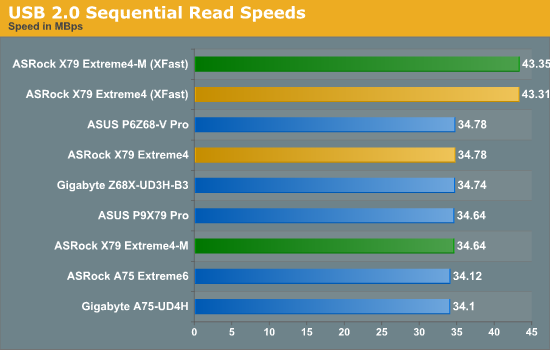
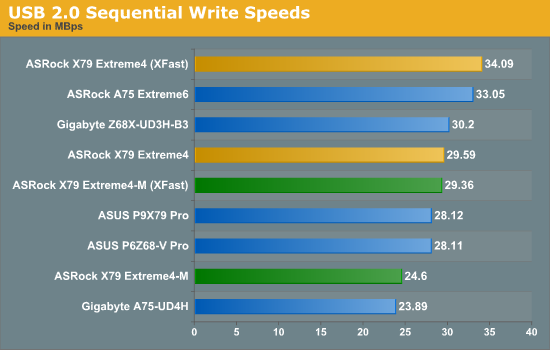
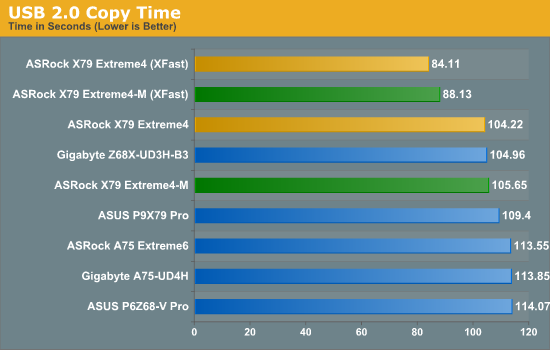
Despite the poor sequential performance of the Extreme4-M, under XFast mode, both boards outperform the rest in the USB 2.0 copy tests, especially the Extreme4.
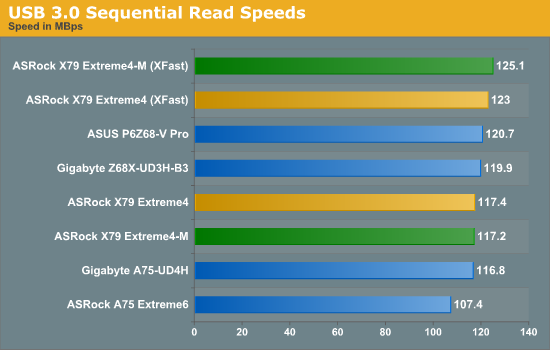
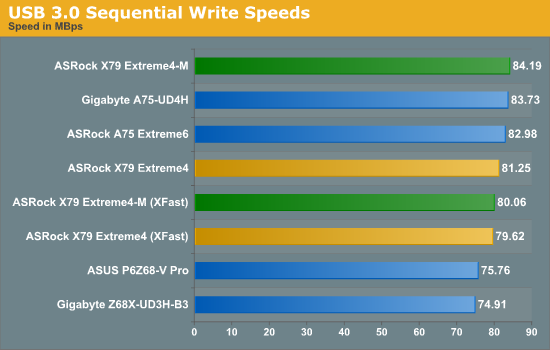
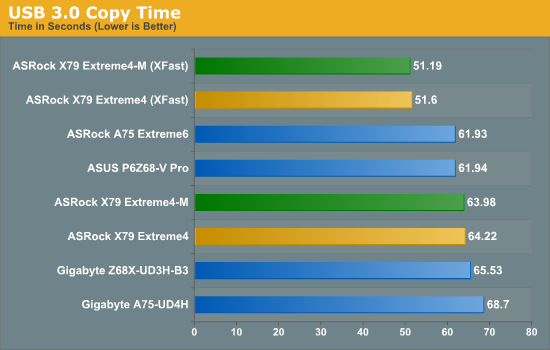
Both boards, under XFast mode, steam past all the other boards in our USB 3.0 copy test, with a 20% decrease in time required.
SATA Testing
We also use CrystalDiskMark for SATA port testing. The operating system is installed on the SSD, and the sequential test is run at the 5 x 1000 MB level. This test probes the efficiency of the data delivery system between the chipset and the drive, or in the case of additional SATA ports provided by a third party controller, the efficiency between the controller, the chipset and the drive.
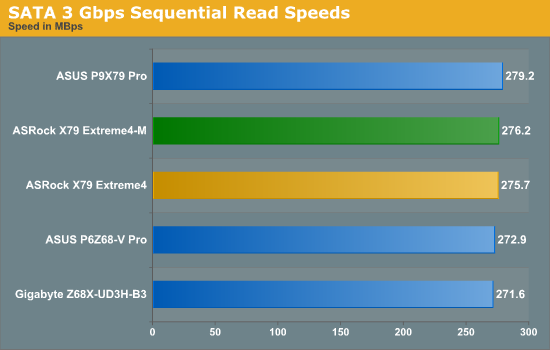
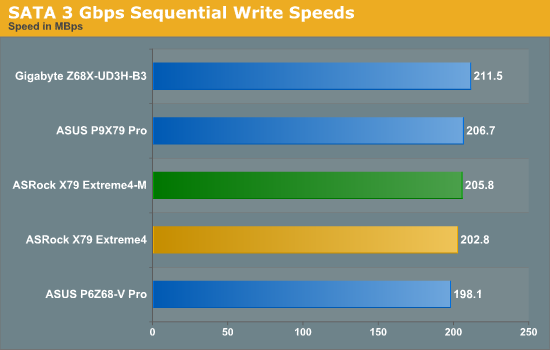
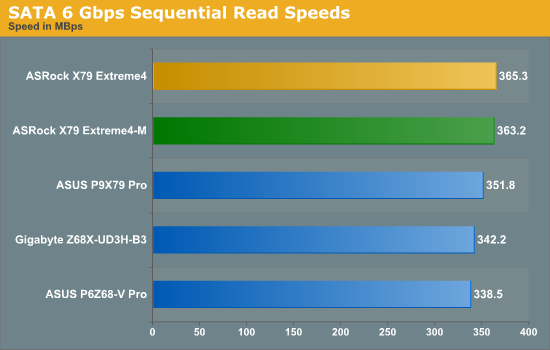
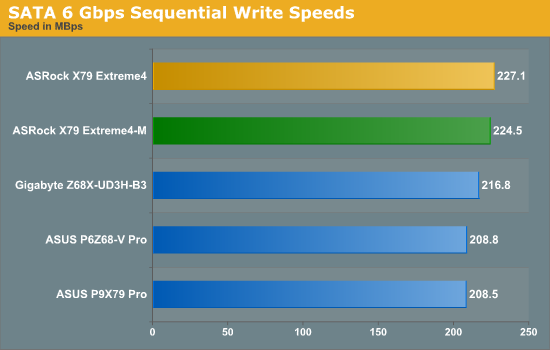
While neither board shines in SATA 3 Gbps testing, in terms of SATA 6 Gbps on our C300, both the X79 Extreme4 and X79 Extreme4-M beat the other X79 and Z68 comparison points.
DPC Latency
Deferred Procedure Call latency is a way in which Windows handles interrupt servicing. In order to wait for a processor to acknowledge the request, the system will queue all interrupt requests by priority. Critical interrupts will be handled as soon as possible, whereas lesser priority requests, such as audio, will be further down the line. So if the audio device requires data, it will have to wait until the request is processed before the buffer is filled. If the device drivers of higher priority components in a system are poorly implemented, this can cause delays in request scheduling and process time, resulting in an empty audio buffer – this leads to characteristic audible pauses, pops and clicks. Having a bigger buffer and correctly implemented system drivers obviously helps in this regard. The DPC latency checker measures how much time is processing DPCs from driver invocation – the lower the value will result in better audio transfer at smaller buffer sizes. Results are measured in microseconds and taken as the peak latency while cycling through a series of short HD videos - under 500 microseconds usually gets the green light, but the lower the better.
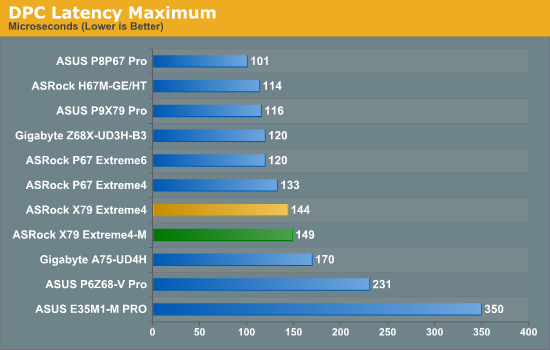
DPC Latency seems to be majorly dependent on the BIOS - it also helps if there is no CPU/fan monitoring software in the background. Both boards here perform well under 500 microseconds, but nothing stellar compared to other products.










54 Comments
View All Comments
DanNeely - Friday, December 9, 2011 - link
A lot more of them do have reasons to be migrated than you'd think. Even 5 years ago I started seeing L shaped cards at the low end ( a tiny strip of PCB along the bracked, and a second for the PCI plug); chopping the 2nd half of the L cuts manufacturing costs by an amount that more than pays for the engineering over larger production runs.Devices that need larger PCBs but which have minimal bandwidth needs are an ever shrinking segment of the market. Even when total bandwidth isn't an issue the fact that PCIe bandwidth is dedicated instead of being shared means you no longer need to put as much hardware into buffering to avoid latency bursts when something else is using the bus more heavily.
Finally, once legacy PCI starts disappearing on a non-trivial fraction of boards total collapse from mainstream devices is inevitable. Once supporting PCIe becomes mandatory it's only a matter of time until redesigning the core chip on the card to be native PCIe instead of PCI and using a PCI-PCIe bridge chip becomes the cheaper option (probably with the next scheduled redesign). While they might initially maintain back compatability with a bridge chip going the other direction; however being doublely niche parts AGP gfx cards from 3 or 4 generations ago is probably a good comparison example. nVidia didn't make any at all, and the handful of ATI 3xxx/4xxx cards went at significant price premiums.
Eventually it'll end up like ISA; if you're willing to pay a large enough price premium (eg because the industrial/lab equiptment you're controlling costs thousands or millions of dollars to replace) there will be a handful of companies willing to sell you semi-custom boards at a large price premium and technology lag. The last time I looked I couldn't find ISA on anything newer than LGA775, until after intel finally pulls the plug on the last 775. That probably won't be for a while; if you look at their CPU database intel hasn't discontinued its embedded p4's yet, and probably won't file a while. IIRC they typically have contractual agreements to keep embedded parts in stock for a decade.
darckhart - Friday, December 9, 2011 - link
nope. still useful for pci graphics cards for troubleshooting video probs.Blibbax - Friday, December 9, 2011 - link
The differences in load power consumption might just demonstrate the margin of error on that test. Worth keeping in mind for other comparisons.The other possibilities are that the 5850s use a lot more power when they're a little bit hotter, and that the power circuitry on the M-ATX board is just awful under high load.
Concillian - Friday, December 9, 2011 - link
I was reading through the article and thought I had hit back instead of forward since I had read the page I was reading before.After finding all my marbles, I noticed that the article has two sets of Page 2 & 3. page order is 1, 2, 3, 2, 3, 4, 5...
hal74 - Friday, December 9, 2011 - link
I am always disappointed to find an article written by Ian. I know that I'll get an article written by someone who fails at plural vs singular when talking about a company and who doesn't come up with interesting comparison charts. Ian chose to throw in an E350 into the mix and didn't even add any comparisons with an x58, or any other core i7. Also, whats with fascination with older video cards in SLI?Is this seriously what people want in an article from Anandtech?
Spivonious - Friday, December 9, 2011 - link
Usually, I'll let grammar mistakes slide, but when I find multiple mistakes on a single page it really starts distracting me from the material.Can we get editors for the articles written by non-native English speakers?
Spivonious - Friday, December 9, 2011 - link
And "tenacity" is used incorrectly."...given ASRock’s previous tenacity when it comes to box bundling."
Does this make sense?
"...given ASRock's previous stubbornness when it comes to box bundling."
JonnyDough - Friday, December 9, 2011 - link
Yes. It does. Maybe your reading comprehension is lacking. The sentence means that ASRock will not budge when it comes to box bundling.Can we get some editors for the comments written by non-literate English readers?
Spivonious - Friday, December 9, 2011 - link
"3.2 GiB limit of 32-bit"*scratches head*
I thought 2^32-1 was 4GiB...
Aisalem - Friday, December 9, 2011 - link
using 32-bit you are able to address 4GB but unfortunately you will not be able to use whole 4GB in most of the 32-bit Windows installations, that also depend on the additional hardware you have.Now you shouldn't *scratches head*.